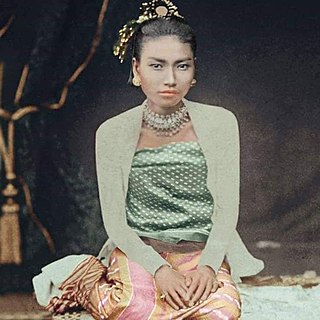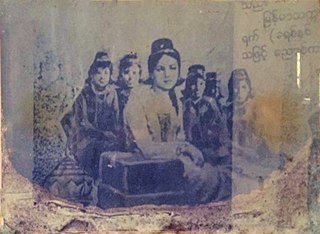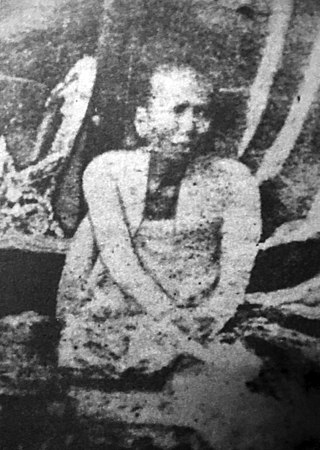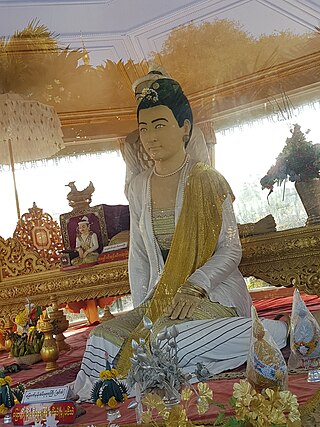
The Konbaung tombs are a collection of mausoleums built by Konbaung dynasty kings. They are scattered throughout the former royal capitals of Mandalay Region, including Mandalay, Amarapura, and Inwa.

The Konbaung tombs are a collection of mausoleums built by Konbaung dynasty kings. They are scattered throughout the former royal capitals of Mandalay Region, including Mandalay, Amarapura, and Inwa.




When a Burmese king died, his royal white umbrella was broken and the great drum and gong at the palace's bell tower (at the eastern gate of the palace), was struck. [1] It was custom for members of the royal family, including the king, to be cremated: their ashes were put into a velvet bag and thrown into the river. [2] King Mindon Min was the first to break tradition; his remains were not cremated, but instead were buried intact, according to his wishes, at the place where his tomb now stands. [2] Before his burial, the King Mindon's body was laid in state before his throne at the Hmannandawgyi (Palace of Mirrors). [3] [4]


Mindon Min, born Maung Lwin, was the penultimate king of Burma (Myanmar) from 1853 to 1878. He was one of the most popular and revered kings of Burma. Under his half brother King Pagan, the Second Anglo-Burmese War in 1852 ended with the annexation of Lower Burma by the British Empire. Mindon and his younger brother Kanaung overthrew their half brother King Pagan. He spent most of his reign trying to defend the upper part of his country from British encroachments, and to modernize his kingdom.

The Konbaung dynasty, also known as Third Burmese Empire (တတိယမြန်မာနိုင်ငံတော်), was the last dynasty that ruled Burma/Myanmar from 1752 to 1885. It created the second-largest empire in Burmese history and continued the administrative reforms begun by the Toungoo dynasty, laying the foundations of the modern state of Burma. The reforms, however, proved insufficient to stem the advance of the British, who defeated the Burmese in all three Anglo-Burmese Wars over a six-decade span (1824–1885) and ended the millennium-old Burmese monarchy in 1885. Pretenders to the dynasty claim descent from Myat Phaya Lat, one of Thibaw's daughters.

Thibaw Min, also Thebaw or Theebaw, was the last king of the Konbaung dynasty of Burma (Myanmar) and also the last Burmese monarch in the country's history. His reign ended when the armed forces of the Burmese Empire were defeated by the forces of the British Empire in the Third Anglo-Burmese War, on 29 November 1885, prior to its official annexation on 1 January 1886.

Amarapura is a former capital of Myanmar, and now a township of Mandalay city. Amarapura is bounded by the Irrawaddy river in the west, Chanmyathazi Township in the north, and the ancient capital site of Ava (Inwa) in the south. It was the capital of Myanmar twice during the Konbaung period before finally being supplanted by Mandalay 11 kilometres (6.8 mi) north in 1859. It is historically referred to as Taungmyo in relation to Mandalay. Amarapura today is part of Mandalay, as a result of urban sprawl. The township is known today for its traditional silk and cotton weaving, and bronze casting. It is a popular tourist day-trip destination from Mandalay.

The Mandalay Palace, located in Mandalay, Myanmar, is the last royal palace of the last Burmese monarchy. The palace was constructed between 1857 and 1859 as part of King Mindon's founding of the new royal capital city of Mandalay. The plan of Mandalay Palace largely follows the traditional Burmese palace design – it is inside a walled fort surrounded by a moat. The palace itself is at the centre of the citadel and faces east. All buildings of the palace are of one storey in height. The number of spires above a building indicated the importance of the area below.

Shwenandaw Monastery is a historic Buddhist monastery located near Mandalay Hill, Mandalay Region, Myanmar.

Bagyidaw was the seventh king of the Konbaung dynasty of Burma from 1819 until his abdication in 1837. Prince of Sagaing, as he was commonly known in his day, was selected as crown prince by his grandfather King Bodawpaya in 1808, and became king in 1819 after Bodawpaya's death. Bagyidaw moved the capital from Amarapura back to Ava in 1823.

Supayalat, also spelt Suphayalat, was the last queen of Burma who reigned in Mandalay (1878–1885), born to King Mindon Min and Queen of Alenandaw. The British corruption of her name was "Soup Plate". She was married to her half-brother, Thibaw, who became the last king of the Konbaung dynasty in 1878, upon Mindon Min's death. She is best known for engineering a massacre of 80 to 100 royal family members, to prevent potential rivals from usurping Thibaw's power, although she had always denied any knowledge of the plot, which may have been hatched by her mother together with some of the ministers, including the chancellor Kinwon Min Gyi U Kaung. U Kaung had traveled around the world and seen for himself the power of the British military. When U Kaung pleaded to the King Thibaw at the Royal court that the kingdom should not go to war with the British, Supayalat angrily says,
"This old man is always timid. He should wear a woman's htamein. Sent a htamein and a thanaka grinding stone to U Kaung's house this evening."

Nanmadaw Me Nu, commonly known by her regnal title Thiri Pavara Mahayazeinda Yadana Dewi was the chief queen of King Bagyidaw of the Konbaung dynasty of Burma from 1819 to 1837. She married Bagyidaw when he was Prince of Sagaing, then became chief queen consort when he ascended to the throne on 5 June 1819, gaining the title Namadaw Mibaya Khaunggyi.

Supayagyi, also spelt Suphayagyi, was the penultimate chief queen consort of the Konbaung dynasty, and was married to Thibaw Min, the last monarch in the dynasty.

Hsinbyumashin was a senior queen of King Mindon Min during the Konbaung dynasty. She was the daughter of King Bagyidaw and his consort Nanmadaw Me Nu (Chief Queen of King Bagyidaw). She was one of the most influential Burmese queen consorts.

Thu Thiri Sanda Wadi, commonly known as the Princess of Taingda, was a royal princess during the Konbaung dynasty. She was also known as a royal goldsmith, renowned for her expertise in working with gems and precious metals; she made jewelry for the royal family.

Thiri Mahamingala Thupabadewi, commonly known as the Laungshe Mibaya or Queen of Laungshe, was a royal princess and senior queen consort of King Mindon during the Konbaung dynasty. She was the queen mother of the Konbaung dynasty's last king, Thibaw Min. Being a cousin of King Mindon, she was promoted to a Nanzwe Mibaya and received the appanage of Laungshe when he ascended the throne.

Khin The, commonly known by her regnal title Thiri Maha Yadana Mingala Dewi, was the Queen of the Northern Palace of King Mindon Min during the Konbaung dynasty. Among several queen consorts, Khin The was the favored queen of King Mindon.

Seindon Mibaya, known by her royal title, Thiri Pobba Yadana Dewi, was a senior queen consort of King Mindon during the Konbaung dynasty. Being a cousin of King Mindon, she was promoted to a Nanzwe Mibaya and received the appanage of Seindon when he ascended the throne.

Thu Thiri Myatswa Ratana Devi, commonly known as the Princess of Salin or Salin Supaya, was the Tabindaing princess during the late Konbaung dynasty. She was nicknamed "Selina Sophia" by Europeans. As a favourite daughter of King Mindon and one who was proficient in mathematics, she served as head of the royal treasury during the reign of King Mindon.

Supayalay was a junior queen consort of the Konbaung dynasty, and was married to her half-brother Thibaw Min, the last monarch in the dynasty, in 1878. She was one of the three only queens of King Thibaw.

Thiri Mahar Thu Mingalar Sandar Dewi, commonly known as Magway Mibaya, was a senior queen consort of King Mindon during the late Konbaung dynasty.
Maha Thu Thiri Dhammayaza, commonly known as the Prince of Thonze or Thonze Minthagyi, was a first-ranked royal prince of the late Konbaung dynasty. He was a senior son of King Mindon and was the Viceroy of Chindwin Province.

Mindon Min, the tenth king of the Konbaung Kingdom, died in Mandalay Palace at the age of 64 on the afternoon of 1 October 1878. A mourning period of seven days preceded his funeral, which took place on 7 October. His son Thibaw was proclaimed the new monarch by the Hluttaw.